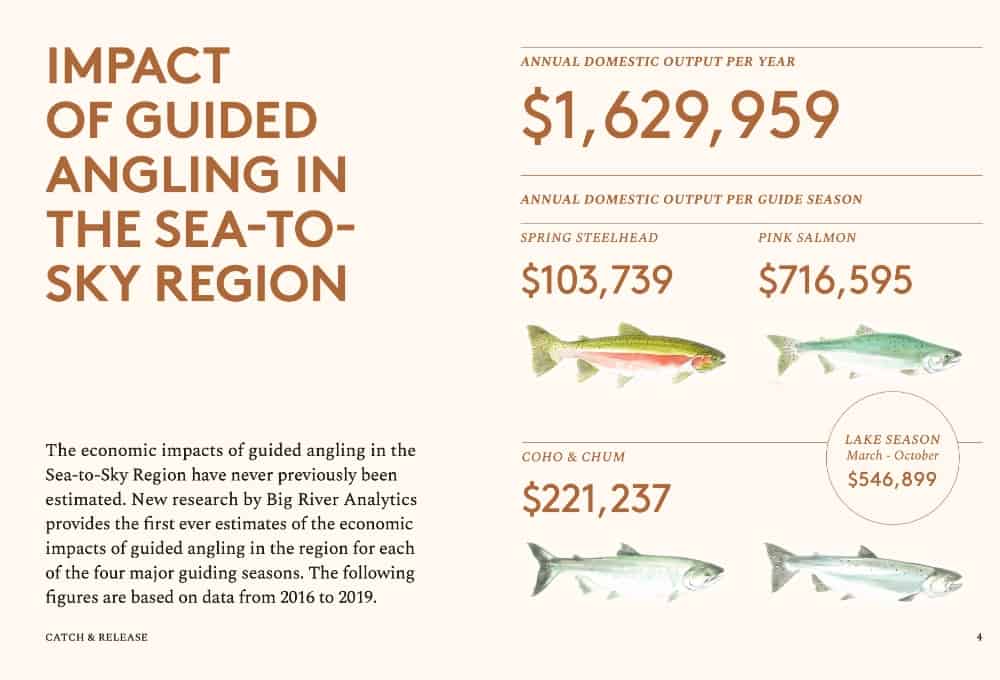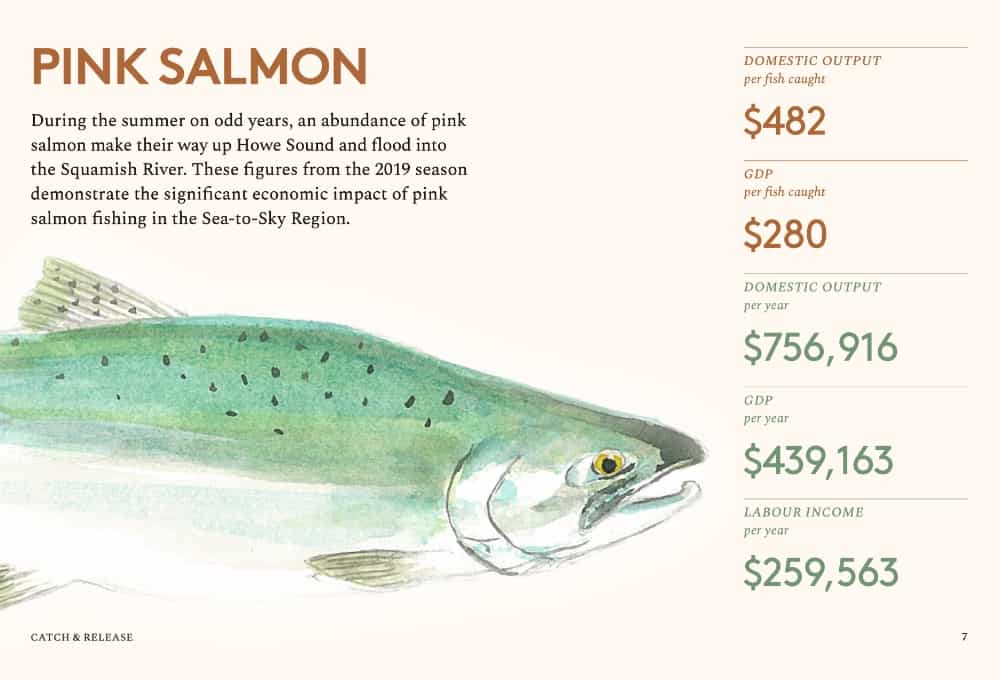23 Jul Sea To Sky Fishing Guides Economic Study
SEA TO SKY ANGLING GUIDE ECONOMIC STUDY
PROTECTING ACCESS TO FISHING IN THE SEA TO SKY CORRIDOR
This is the story of how a group of angling guides in BC’s Sea to Sky Region banded together to get some recognition, and hopefully a greater voice when it comes to local fisheries decisions. What is the value of fishing and how do guiding operations contribute to the local economy? How much is each fish worth? These are questions that needed to be answered. Answers that we hope will save our livelihoods and our local fisheries.
THE HISTORY
In early October 2020 there was a lot of confusion regarding salmon fishing regulations on the Squamish River and its tributaries, including the Mamquam and Cheakamus rivers. My phone was ringing, “hey what’s the story with chum fishing, we can target them, but just can’t keep them right?” Having spent the better part of 25 years reading (and religiously following) BC fishing regs I had to read and reread the salmon regulations surrounding the Squamish watershed. My answer of “I think so” was wrong.
Sometime in mid October I sat in on a SFAB (Sport Fishing Advisory Board) meeting, chaired by local representative Dave Brown. These meetings, now down via Zoom, are a chance for stakeholders and the sport fishing public to have communication with the federal Department of Fisheries and Oceans (DFO) and discuss fishery related topics. Chum salmon on the Squamish River was a hot topic that night and the regulations were quickly clarified. “No, you cannot target chum salmon, only hatchery clipped coho salmon”. That was straight from the Region II heads of DFO, Barbara Mueller and Dean Allen.
In the midst of a pandemic, during a time where the BC tourism industry had all but been decimated, this was a blow we could have done without. Fishing for chum salmon has long been a popular past time on the Squamish River, for locals and visitors.
Up until 2021, public access to fisheries was open until closed. Now things had changed. Fisheries were closed until open, a huge policy shift from within DFO in Ottawa that had, and has, infinite repercussions to public use of public fisheries. Now if you don’t go fishing, or you’re not in the sport fishing industry in BC, then this will have zero impact on your daily life. For those of us who love fishing, or who find our livelihoods dependant on access to a public resource, then all of a sudden there was great reason for worry.
This was the first time in my 20 year history of guiding in the Sea to Sky corridor that we were not allowed to target chum salmon. The explanation for the closure was “anecdotal information”. This was the reasoning behind DFO not allowing anglers or guiding operations to target chum salmon. There was no scientific data, to any of our knowledge, to support the closure. Have chum salmon numbers declined on the Squamish River in the past 5, 10, 15 years? Anyone who has fished the system over that time frame will tell you that chum salmon numbers have declined. There are less chum in the river now than there was 10 years ago, few people would argue against that. But when government makes decisions on anecdotal information and not on science or quantitative date there is a reason to be worried. The same issue has plagued BC’s south coast saltwater chinook salmon fishery, seeing it closed for much of the year, with little explanation to why.
So now one of our main Fall fisheries, with a stroke of DFO’s pen, was wiped off the slate and a significant part of the Sea to Sky’s public fishery was no longer. Guiding operations in the Sea to Sky corridor are, for the most part, catch & release operations with minimal impact on fish stocks. Our plea for an opening was not for a retention (keeping) opening, simply a catch and release opening where we could swing flies for salmon as we always had.
A chum salmon on the lower Squamish River 2017.
WHY AN ECONOMIC IMPACT STUDY?
It was Fall 2020 and DFO had only given us the opportunity to target hatchery coho, but fishing guide operations and local anglers were now feel the pinch. What if hatchery coho numbers were low, would we have even had a Fall fishery on the Squamish? We had watched the saltwater charter companies fight for access to chinook salmon over the past several years and could see the writing on the wall in our own backyard. DFO’s management mandates were now focused on limiting recreational angling use more than ever before.
When it came to saltwater chinook fishing, the hard work of the SFAC (Sport Fishery Advisory Council), Sport Fishing Institute and Public Fisheries Alliance had all but fallen on deaf ears with DFO. DFO had made their decision to take away public access to chinook fishing and we were now looking down the same barrel when it came to chum fishing on the Squamish River. If they were so quick to close the chum fishery to catch and release fishing, then what was next?
In late October I spoke with Brian Niska. Niska, who has a long history of guiding in the Sea to Sky, is now based in Terrace, BC. Although no longer actively guiding in the area, he was concerned that the chum fishery had been pulled from local anglers and forecasted that this was a slippery slope of fisheries management.
Yes, we could write letters and hold rallies and tell DFO that they weren’t being fair but that was only going to go so far. So, the idea of an economic impact study came up. In 2019 the Skeena Angling Guide Association (SAGA) initiated an economic impact study of the Skeena River fishery, after DFO began stringent measures against salmon fishing on the lower Skeena River and some of its tributaries. The study was the first of its kind in British Columbia and offered undeniable data and numbers of how much the sport fishery was generating for the local economy. This was a snippet from the Lower Skeena Angling Guide Economic Study’s conclusion: Direct angler expenditures totalled over $10.5 million in 2016, producing $16.5 million in total domestic output across BC and $8.7 million in terms of GDP. Taken together, 2016 guided angling in the Lower Skeena region supported 190 local jobs and 224 jobs across BC, generating more than $2.7 million in taxes province-wide. A visual report of the study is linked here.
Now the hope was that a similar economic impact study done for the Sea to Sky region would give us an idea of how the local guiding community contributed to the BC economy. It was (and is) a long term play. The plan is to use the findings of the economic impact study to curtail closures and show the value of keeping sport fishing opportunities alive and well from both economic and social standpoints.
HOW DOES THE STUDY WORK?
The economic impact study of Sea to Sky angling guides took the financials and catch reports from five active fishing guide operations that work in the Sea to Sky region. The five operations were; Valley Fishing Guides operated by Clint Goyette, Pacific Angler operated by Jason Tonelli, Whistler Fishing Guides operated by Brian Leighton, Pemberton Fish Finders operated by Brad Knowles and Chromer Sport Fishing operated by myself, Yos Gladstone.
The project was headed by Hannes Edinger & Alexander Cebry, and their staff, at Big River Analytics. Big River Analytics (BRA) specializes in these particular kinds of projects and were also behind the Lower Skeena River Angling Guide Economic Impact Study.
BRA collected financial reports from the five guiding companies from the years 2016, 2017, 2018 & 2019. They also collected our Angling Guide Reports from those years. Angling Guide Reports are submitted annually by all licensed guiding operations. They included a record of guided days, which waters were fished each of those days and residency of clients. They also included what species of fish were caught, how many and whether fish were released or retained. Submitting these reports on an annual basis is mandatory for all freshwater angling guides in British Columbia.
The report also took into consideration other expenses, including angler hotel stays within the Sea to Sky corridor, angler expenses and guide expenses, fuel, gear, etc. that was recirculated into the local Sea to Sky economy.
THE REPORT & RESULTS
Once everything was compiled and Big River Analytics did their statistical work with the financials and catch reports we had a clearer idea of our economic impacts in the region. A lengthy detailed report, available here, lays out all guided angling activity and the economic benefits from it. This gives readers a full overview of what guided angling in the Sea to Sky corridor generates both regionally and provincially. It was evident that the primarily catch and release fisheries in Squamish, Whistler & Pemberton carried big economic benefits.
Key figures were then compiled into a visual report, a link to a PDF version of the visual report is here. You can also see it in full below. The visual report breaks down the most important fisheries of the Sea to Sky Region and puts a value number on every fish caught by guided operations.
It should be noted these are simply stats from five small guide operations. These fisheries are also enjoyed by a large contingent of local anglers, who also contribute greatly to the local communities of Squamish, Whistler & Pemberton. To tally the totals of unguided fishing in the region is a project in itself, and not something we currently had funding or timing to initiate.










OUR HOPES MOVING FORWARD
Fighting for access to public fisheries isn’t an issue that will go away anytime soon. As anglers we need to be proactive. This means fishing in sustainable ways, being mindful of our individual impacts and working to secure our rights as Canadians to be able to go recreational fishing.
Freshwater and saltwater sport fishing combined makes for a $1 Billion industry in British Columbia. BC’s Sea to Sky corridor is an integral region for sport fishing, offering easy access for locals from Vancouver, Squamish and Whistler. It also offers an amazing introduction to sport fishing for visitors from around the world. The close proximity to the tourism meccas of Whistler & Vancouver makes it an extra important component of the local tourism industry.
With the findings in the study it is evident that guided fishing operations have little impact on fishery stocks but have huge economic benefits per fish caught to the local economy. Access to fisheries is the lifeblood of our small operations and those we employ, the the ripple effect is much greater. The Sea to Sky economy sees undeniable benefits from people coming to fish our waters.
The plan moving forward is to put this study in front of as many people as possible. This will include decision makers in DFO, MPs and MLAs in southwestern BC, tourism organizations and the media. Sport fishing is a big part of the fabric in the Sea to Sky region, both socially and economically. We want to make sure our local fisheries stay healthy, respected and available for many generations to come.
Please consider sharing this post or forwarding it on to your friends. Thank you for your interest.
![]()
About the Author
Yos Gladstone is the owner operator of Chromer Sport Fishing, a guiding company and booking agency based in British Columbia, Canada. A full-time salmon & steelhead guide, Yos spends 200+ days a year on the water fishing, guiding and hosting trips.